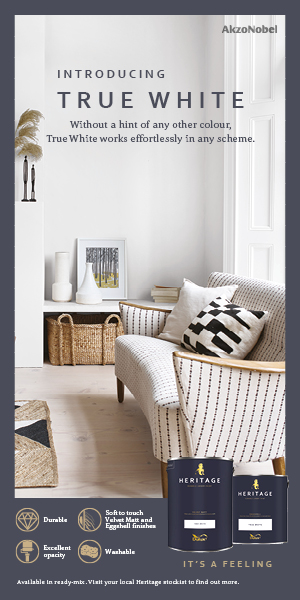Dementia Support Through Colour and Design

For professionals looking to design a space to aid people living with dementia, Crown Paints has a wealth of knowledge available.
There are approximately 850,000 people in the UK who live with dementia, with this number expected to increase to a million by 2025. For those who have dementia, strategic design can enhance their environment and help them to remain independent for longer. So, understanding how to use colour, texture and material to create a practical and welcoming space is vital. Colour use and pattern is crucial, as an inappropriate choice can be confusing.
Understanding which colour should be used requires an understanding of how our perception of colour can change as we grow older. As our eyes age, colours become duller, so stronger, richer colours are easier to recognise and remember, while pastel shades become harder to distinguish.
When considering how to create a homely space for people with dementia, it is worth considering a number of elements. Flooring, furniture, soft furnishings and wall colour all contribute to the final product. Successful colour schemes happen when all these elements harmonise with one another to create a balanced and aesthetically-pleasing scheme. It’s worth bearing in mind that warm hues such as reds and oranges, will stand out more for someone living with dementia.
Meanwhile, tonal contrast is essential to help a person understand space and, in large buildings, can assist navigation by providing differentiation between different areas. Colour can provide tonal contrast to highlight critical areas, for example toilet or bedroom doors. Camouflaging doors that are off limits, such as store cupboards, by painting them the same colour as the walls is also a useful technique to limit people entering them. Additionally, handrails alongside steps and on stairways should contrast against the wall colour to make them easily identifiable, so too should chairs, kitchen work surfaces, toilet seats, as well as taps on sink units, as this helps make spaces more accessible.
Unless there is a change of floor level, similar toned flooring should be used throughout the space. Strong patterns or a change in floor colour can be mistaken for a step and cause confusion resulting in someone overcompensating or misjudging the stride distance. Additionally, rugs can be trip hazards and can be an obstacle for people that experience misperception difficulties.
It is worth considering that while patterns can be stimulating and create interest in an interior, they can also be overwhelming. Familiar patterns are reassuring, but in unfamiliar surroundings, can cause confusion. Strong geometric patterns can distort space, while patterns with small motifs can be misinterpreted for bits of fluff. Wall prints and designs can add a point of reference for wayfinding, but realistic digital wall prints – such as a pathway leading to a forest – may cause confusion.
Designing a safe space for those living with dementia is no small feat and takes careful consideration across each and every aspect of the process. To empower designers with the right tools for the job, Crown Paints has launched ‘Colour in Design’, a suite of Continual Professional Development (CPD) courses which aim to help architects, designers and specifiers to advance their knowledge and skills around how colour can be used to support their work.
The ‘Colour Design for Dementia’ module is a key component of it, exploring how to guide the design of a dementia care setting. Other courses include Colour Families, which studies each colour’s history, associations and variations, as well as Inclusive Colour & the Equality Act, Colour Application, Colour Notation, Light & Lighting, Colour Psychology and Physiology and Technical Colour
Recognised as an industry expert in colour and as a trusted partner for the specification sector, Crown Paints offers a range of services to support and inform painting, decorating and architecture professionals, within which CPD is a key pillar. For those looking to create a design which helps and supports those living with dementia, these courses can provide a wealth of knowledge to aid them.
As the number of people living with dementia in the UK continues to rise, there is only going to be a greater need for professionals who have the know-how to create a safe space which can accommodate them and to support them to remain as independent as possible.








